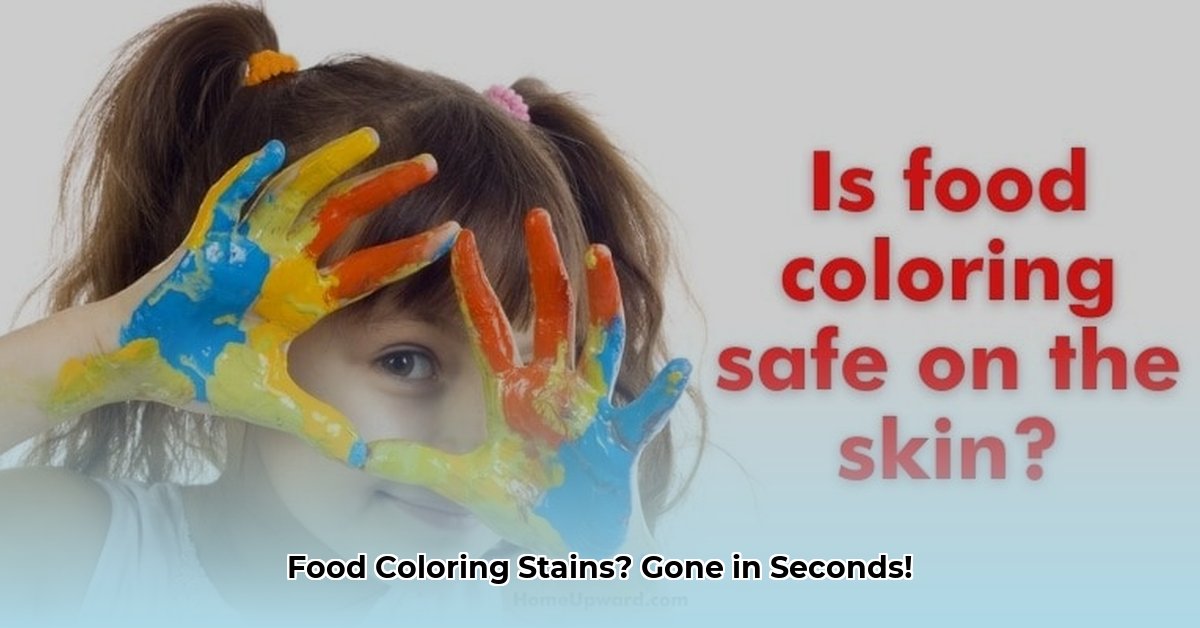Banishing Food Coloring Stains: Quick Fixes & Proven Methods
Dealing with stubborn food coloring stains? Whether it’s a post-Easter egg decorating mishap or a baking project gone a little too colorful, we’ve got you covered. This guide offers simple, safe, and effective ways to remove food coloring from skin, using common household items. Relax, it’s not permanent! Let’s get that skin back to its normal hue.
Choosing the Right Removal Method
Different stains call for different strategies. This handy chart helps you pick the best method based on the stain’s stubbornness and your skin’s sensitivity:
| Method | Best For | Notes |
|---|---|---|
| Soap and Water | Fresh stains, all skin types | Gentle, readily available, always a good first step |
| Whitening Toothpaste | Most stains (except very sensitive skin) | Avoid on the face due to abrasiveness |
| Shaving Cream | Light to medium stains, sensitive skin | Gentle and convenient |
| Rubbing Alcohol/Hand Sanitizer | Stubborn stains | Can dry skin; moisturize afterward; use cautiously on sensitive skin |
| Vinegar | Most stains | Dilute for sensitive skin, can be slightly drying |
| Baking Soda Paste | Stubborn stains | Gentle rubbing only; good for most skin types |
| OxiClean | Heavy stains on hands and body only | Not for use on the face |
Some food colorings, especially darker shades, are more likely to stain. Individual skin types may also react differently to cleaning methods. While these methods are generally safe, testing a small area first is always wise, particularly for sensitive skin. Stop if any irritation occurs, and consult a dermatologist if needed.
Step-by-Step Stain Removal Instructions
1. Soap and Water: The First Line of Defense
This simple method often does the trick, especially for fresh stains.
- Wet the stained area with lukewarm (not hot) water.
- Lather with mild soap. Dish soap works well, but any gentle hand soap is likely fine.
- Gently rub the area for 1-2 minutes.
- Rinse thoroughly.
- Repeat if a faint stain remains.
2. Whitening Toothpaste: A Gentle Abrasive
Whitening toothpaste (non-gel) can be surprisingly effective. The mild abrasives help lift the stain.
- Apply a small amount of toothpaste to the stain.
- Gently rub in circular motions for 1-2 minutes.
- Rinse with warm water.
- Repeat if necessary.
- Caution: Avoid this method on sensitive skin, especially on the face, as it may cause irritation.
3. Shaving Cream: A Soothing Solution
Shaving cream can help remove light to medium stains, and is generally gentle on the skin.
- Apply a dollop of shaving cream to the stain.
- Gently massage it in.
- Let it sit for 30-60 seconds.
- Wipe clean with a damp cloth and rinse.
4. Rubbing Alcohol or Hand Sanitizer: For Stubborn Stains
For tougher stains, rubbing alcohol (isopropyl alcohol) or hand sanitizer can be helpful.
- Soak a cotton ball in rubbing alcohol or hand sanitizer.
- Gently dab (don’t rub) the stain.
- Use fresh cotton balls as the color transfers.
- Rinse thoroughly.
- Moisturize afterward, as alcohol can dry the skin.
- Caution: Use with care on sensitive skin.
5. Vinegar: A Natural Cleaning Agent
White vinegar’s acidity can help break down food coloring.
- Soak a cloth or cotton ball in white vinegar.
- Gently rub the stain.
- Rinse thoroughly.
- Note: Dilute the vinegar with water for sensitive skin.
6. Baking Soda Paste: A Gentle Scrub
Baking soda acts as a mild abrasive to lift the stain.
- Mix baking soda with water to form a paste.
- Apply the paste to the stain.
- Gently rub in circular motions.
- Rinse thoroughly.
7. OxiClean: A Last Resort (For Hands and Body Only)
OxiClean can be very effective for stubborn stains, but avoid using it on the face.
- Dissolve OxiClean in warm water according to package directions.
- Soak the stained area for 15-20 minutes.
- Rinse thoroughly.
- Caution: This method is not suitable for the face.
Understanding and Preventing Food Coloring Stains
Why Food Coloring Stains: The Science Behind It
Food coloring molecules are designed to cling. Porous surfaces, like skin, absorb these molecules, making stains more challenging to remove. The type of food coloring also matters: liquids tend to stain more readily than gels or pastes.
Prevention Strategies: Staying Stain-Free
- Gloves: Wearing disposable gloves creates a barrier between your skin and the dye.
- Protect Surfaces: Cover your work area with plastic wrap, wax paper, or a silicone mat.
- Choose Wisely: Opt for gel or powdered food colorings, or consider natural dyes like beet juice or turmeric.
- Start Small: Begin with a small amount of coloring and add more gradually.
By understanding the science behind staining and taking preventive measures, you can minimize the chances of ending up with colorful skin. While accidents happen, these tips will help keep your kitchen creative and stain-free! And if a stain does occur, remember the methods outlined above to get your skin back to its natural color quickly and safely.
- Affordable Employee Wellness Fair Ideas for Any Budget - December 14, 2025
- Employee Wellness Programs Strategically Benefit Employee Health And Retention - December 13, 2025
- Health and Wellbeing Companies Driving Employee Engagement and Productivity - December 13, 2025
















